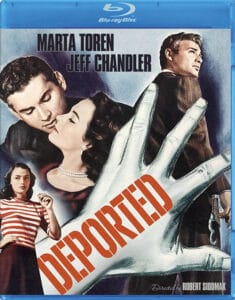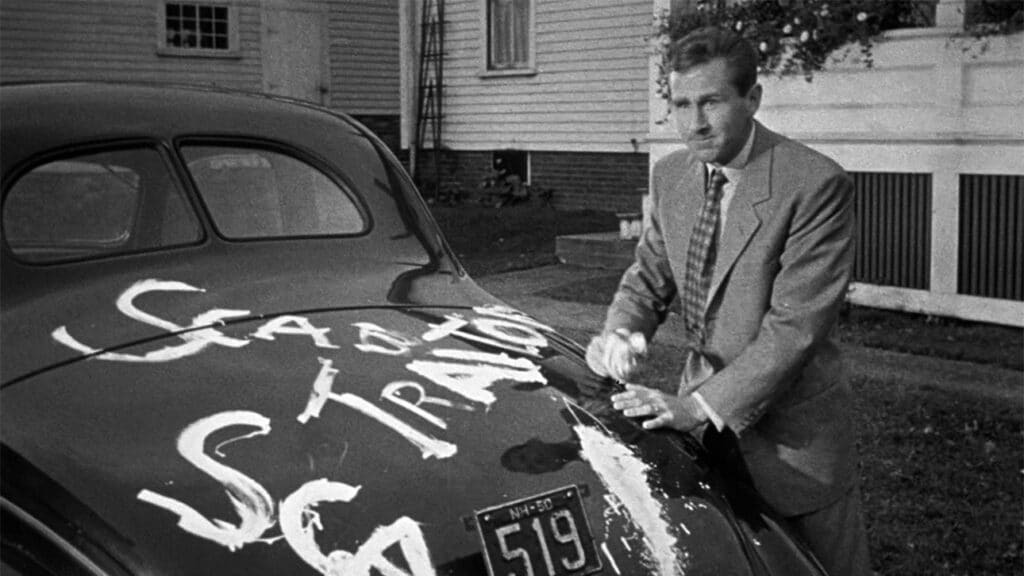

After fleeing Hitler’s Germany, which wouldn’t employ Jews in the film industry, Robert Siodmak made a reputation in Hollywood with atmospheric thrillers. By the dawn of the 1950s, he felt the pull of postwar Europe, where he’d spend the rest of his career. Newly available on Blu-ray are two of his last and most obscure Hollywood items, made one after the other. The first of these was largely shot in Italy, where it was possible to have great production values very cheaply. The second was made in exotic Pennsylvania, which was far from Hollywood but evidently not far enough.
The last phase of Siodmak’s career beckoned, and he was nearly there. To study his transition properly, at last, we’re treated to wonderful digital transfers of these largely forgotten films. Kino Lorber presents Universal-International’s Deported (1950), while the folks at Flicker Alley have exhumed and restored a title once thought lost, The Whistle at Eaton Falls (1951).
Deported‘s Class Discrimination
As the title tells us, Deported (1950) is about reverse immigration, the kind where your adopted country annuls the agreement. The film begins with Vittorio Sparducci, alias Vic Smith (played by an excellent Jeff Chandler with a square chin and chip on his shoulder), arriving at Naples, where urchins scramble at the docks for whatever people throw them. Vic tosses a coin into the water and watches with delight as a boy dives for it, later praising the boy for being smarter than the others.
His patronizing attitude will later be criticized by an upper-crust contessa, all glamour and noblesse oblige, who finds him strangely attractive and brashly American. She offers an angry critique of his “dog-eat-dog” encouragement of competition, and he finds this hard to understand because he’s sullenly proud of having risen from a destitute background.
Rules require him to return to his family’s village, where he’s greeted as a hero by Uncle Armando (Silvio Minciotti), the kindly baker. The whole town, knowing nothing of the criminal background that got Vic deported after a prison stretch, sees him only as a rich American, a symbol of everything they need: the local boy who made good in America, the victorious vanquisher of fascism, the occupying U.S. army, the bountiful philanthropist. He’s a tabula rasa upon which they project their dreams, and he really doesn’t see them either.
In the background, a crime story percolates about his unregenerate partner in a robbery, Bernardo (Richard Rober), and the latter’s openly sexual squeeze Gina (Marina Berti), who makes a fool of the self-satisfied Vic not once but twice. It’s hard for him to learn from his mistakes. This plot is hardly important except as a comment or parallel with Italy’s thriving black market in the postwar inflation, two forms of exploitation that ally in common cause.
The script by writer-producer Robert Buckner, from a story by war correspondent Lionel Shapiro, proposes that if everyone is so delusional as to believe Vic is better than he is, their beliefs might influence or infect him, causing him to rise to their expectations as, for the first time in his life, something better is expected of him, a capacity for good is believed of him. Thus our identities are created by those around us who mold our experience, whether dog-eat-dog or family feeling or war or recovery, and that’s how this becomes a story of bewildering redemption almost against Vic’s will.
To aid the cause, these better angels are embodied in the rich, philanthropic, classy Contessa Cristina di Lorenzi (Marta Toren), whose strange attraction to Vic carries a set of social expectations new to him, above his station really, beyond his context. The village perceives them as on equal footing, the Old World aristocracy and the New World nouveau riche whose father used to be the gardener. A trip to democratic America has raised Vic’s stock and made him worthy to woo the Old World, which needs his new brash blood to galvanize its torpor.
Apart from the mythology of gangster films and their paradoxical tendency to idolize and condemn at once, this film’s deepest irony is that the rich beloved Yankee is a Bad Guy. The irony reaches a heady apotheosis when the celebratory throngs call for Vic to address them from a high classical balcony just like Mussolini. Here’s the crowd ready to canonize another bigshot. Does this point register with all audiences? It’s not quite part of the surface meaning, but I must believe Siodmak did it purposely. This world is hijacking and converting Vic for its own purposes.
Only brief portions of the film deal with crime and only the climax uses shadowy noir photography, brilliantly shot by William H. Daniels. Most of the story is a sun-drenched Italian postcard, mainly outdoors in real locations of lush and picturesque qualities that overwhelm Vic and place him in a context he’s never known or doesn’t recall. It’s really Italy itself, his forgotten and disdained native country, that works its healing magic on him. For example, his first meal in the village is outdoors, surrounded by well-wishers, with big leaves decorously hanging from the top of the film’s frame and a magnificent vista behind him.
The careful placing of characters within these contexts looks forward to such “landscape” commentaries as Roberto Rossellini’s Voyage to Italy (Viaggio en Italia, 1954) and the films of Michelangelo Antonioni. As film historian Eddy Von Mueller reminds us in his commentary, it’s also part of the impact of Italian Neorealism on Hollywood. And while this film isn’t quite noir, being far too sunny and optimistic, we’re reminded that the first major work of Neorealism was probably Lucchino Visconti’s outdoorsy Ossessione (1943), based on James M. Cain’s 1934 novel, The Postman Always Rings Twice.
The film’s bemused optimism remains Siodmakian. While most of his films posit that society has a collectively negative or entrapping influence upon his characters because it’s always society that affects the individual rather than vice versa, here he acknowledges with irony that society can also have a positive or ennobling effect upon his protagonist. In either case, the struggle is useless. This is more or less the comic flipside of his fatalism.
Von Mueller places the film within four themes: Neorealism, the real-life career of Lucky Luciano, the Hollywood rise in productions shot in Europe for legal and financial reasons, and the politics of the Marshall Plan to rebuild a conquered Europe in a capitalist, democratic, above all anti-Communist image. His summary is worth quoting:
For American audiences, it’s a kind of gentle Marshall Plan propaganda, a melodramatic reminder that the world needs American capital and American compassion. For audiences abroad, it’s almost a plea for forgiveness, a reminder that for all the insensitive, clumsy, profiteering, girl-chasing and norm-busting, Americans aren’t all that bad, and a reminder that since it’s such a young country, most of us haven’t been Americans for very long. Before that, we were something else.
– Eddy Von Mueller


![Call for Papers: All Things Reconsidered [MUSIC] May-August 2024](https://www.popmatters.com/wp-content/uploads/2024/04/all-things-reconsidered-call-music-may-2024-720x380.jpg)



